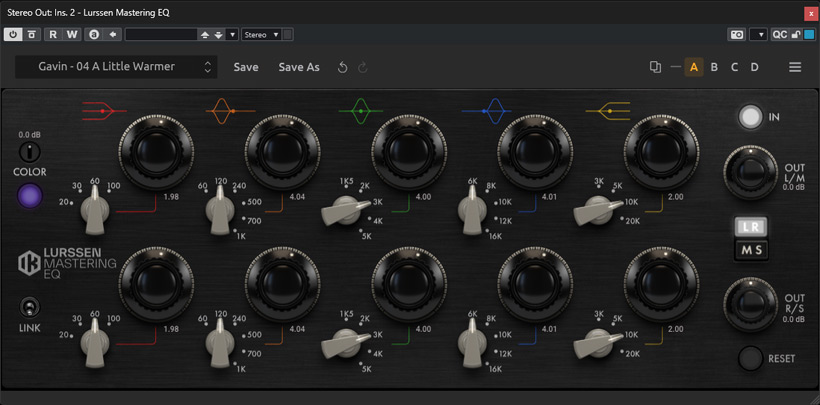Lurssen Mastering Console & Lurssen Mastering EQ
Mastering Suite from IK Multimedia
Author: Peter Kaminski
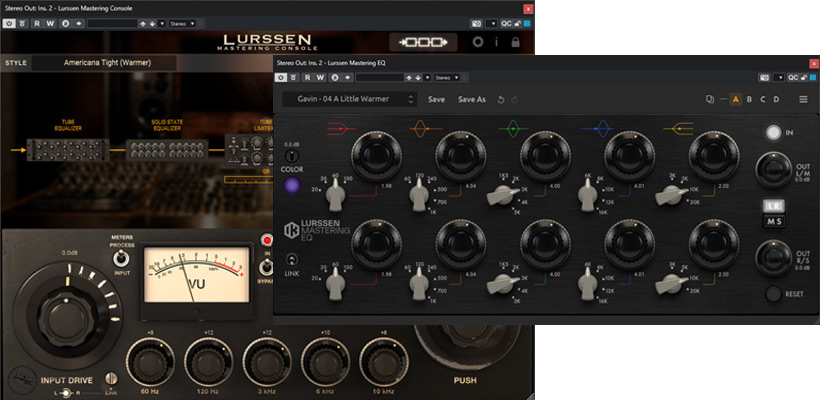
Lurssen Mastering is a mastering studio in Los Angeles founded by Gevin Lurssen and Reuben Cohen. Gevin Lurssen is a four-time Grammy winner. Reuben Cohen has received a Latin Grammy and a TEC Award. Thus, they are not unknown and are also very successful mastering engineers. The studio is equipped for both stereo and Dolby Atmos mastering. However, the tools we present here are only suitable for mastering stereo productions.
The first product to emerge from the collaboration between Lurssen Mastering and IK Multimedia was the Lurssen Mastering Console. The Lurssen Mastering EQ followed in March 2025. Both are also available as a software bundle called the Lurssen Mastering Suite from IK Multimedia. We want to introduce both products here, but it should be noted that the products are likely to appeal to different target audiences.
Installation and requirements
Both products are available for macOS (from 10.15) and Windows operating systems (from Windows 10). There is also an iOS version of Lurssen Mastering Console with an in-app purchase option, but we won't consider that here. To install, you need to enter the serial number of the bundle or the individual product in the IK Multimedia Product Manager. This requires a user account on the IK Multimedia website.
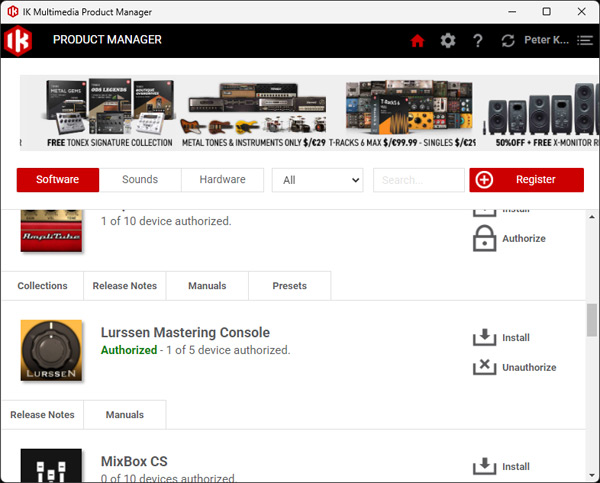
Lurssen Mastering Console is available for installation as a stand-alone and plug-in, while the EQ is available exclusively as a plug-in. The Lurssen Mastering Console is listed as a single product in the Product Manager and can then be installed.
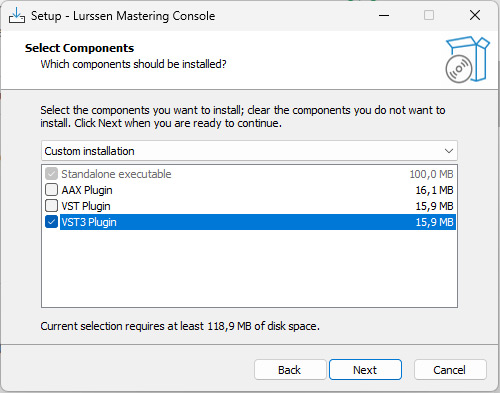
The supported plug-in formats are VST 2, VST 3, AAX, and AudioUnit (for macOS).
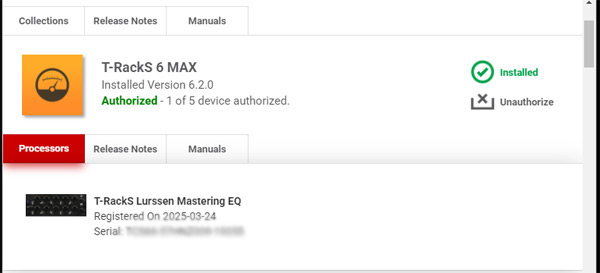
If you have purchased the bundle or the equalizer individually, you need to navigate to the T-RackS tab and then to the “Processors” tab to install the EQ (see figure above). This is because the Lurssen Mastering EQ can be integrated via the T-RackS shell, although it is not part of the T-RackS 6 MAX bundle.
Lurssen Mastering EQ
The Lurssen Mastering EQ is a simulation of the EAR 825Q two-channel five-band tube equalizer, developed by the English engineer Tim de Paravicini, who unfortunately passed away in 2022. He had founded the company EAR Yoshino (EAR stands for “Esoteric Audio Research”) in the UK in 1977. Paravicini developed many high-quality and legendary components not only for the hi-fi consumer sector, but also for studio technology.
In the original EAR 825Q, three transformers, three PCC88 type tubes in the amplifier stage, and four coils were used per channel. The equalizer was legendary but also very rare. Because of high demand, original units were sold for more than 5000 euros. Therefore, various projects aimed to create a replica of the equalizer. A commercial replica is, for example, the 825EQ from IGS Audio, which also costs around 4000 euros. Incidentally, the layout of the Lurssen Mastering EQ looks similar to the IGS Audio EQ.
The Lurssen Mastering EQ offers the same filter frequencies as the original. The EQ has a high and low shelf filter, each with four selectable filter frequencies, as well as three band filters with five switchable frequencies. The adjustable gain range is between -34 and +34 dB. This is a very large adjustment range for an equalizer.
The original had a dual-mono design. With the Lurssen Mastering EQ plug-in, both channels can be linked for stereo operation, and it can be switched to MS processing (Mid/Side). The COLOR switch can be used to turn the preamplifier simulation on or off and then adjust a saturation (-15... +15 dB) that provides a tonal coloration.
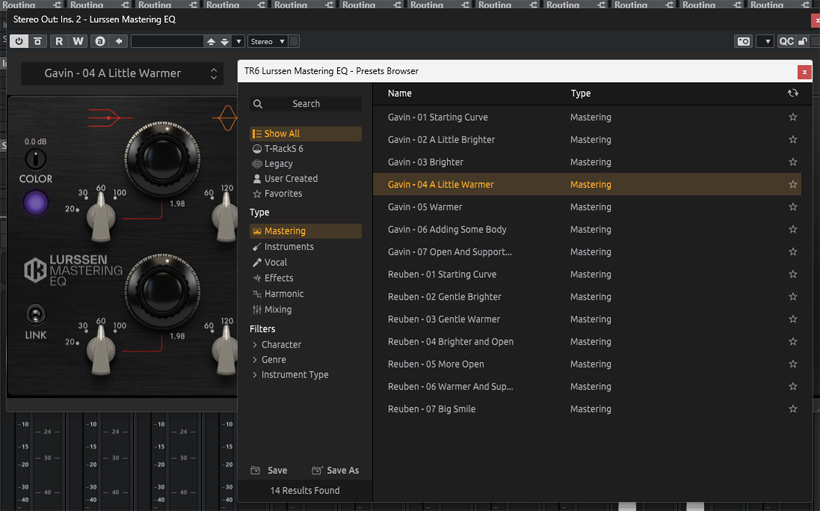
Gevin and Reuben created many presets for the plug-in, which can be selected via the preset browser. These provide a good starting point - but anyone who uses an EQ like this for mastering will probably work without presets and rely more on their ears. Incidentally, Lurssen Mastering EQ can be used as a standalone plug-in or via T-RackS (see figure below).
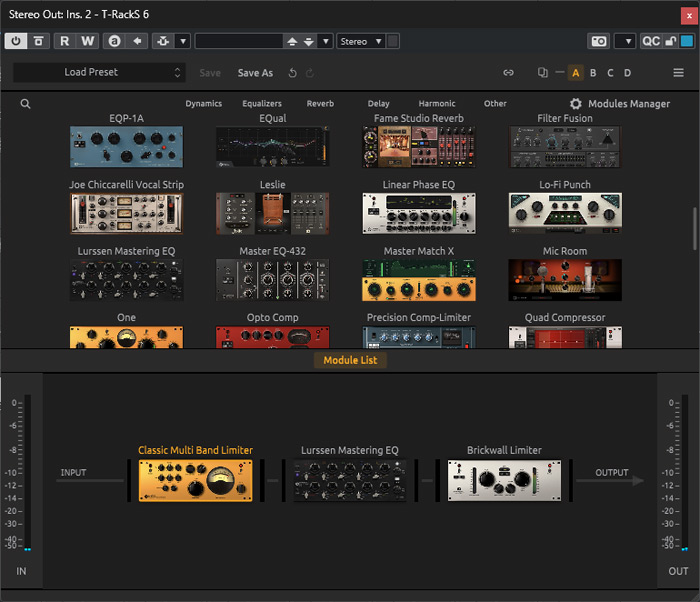
Now to the sound of the Lurssen Mastering EQ: The quality or bandwidth of the filters is fixed. The quality is relatively low or, in other words, the filter bandwidth is relatively large, and the bands also overlap somewhat. This results in a very soft setting, which is exactly what I personally want for a mastering EQ to edit the basic sound. You have to be careful with the gain setting because the +/- 34 dB control range is quite extreme. For finer adjustment, you can hold down the Shift key on your keyboard while changing it with the mouse, which allows you to adjust the gain very precisely.
The additional harmonics that are added via the color function can also be adjusted very finely and subtly. The highlight compared to the original is the mid/side channel, which is a great option for mastering. Of course, the Lurssen Mastering EQ can also be used in a sum. However, other equalizer concepts are more likely to be used for processing instruments. In any case, the main area of application is audio mastering.
Lurssen Mastering Console
Now to the second product in the Lurssen Mastering Console range from IK Multimedia: The name suggests that it works in a similar way to the T-RackS Mastering Console - however, the concept is quite different.
The plug-in can be used as a plug-in or as standalone software.
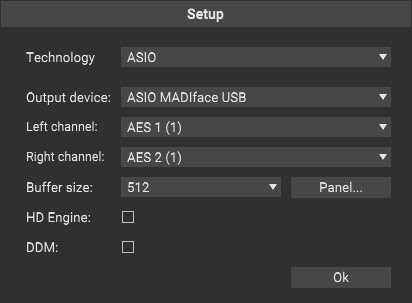
In the standalone version, the audio interface can therefore also be configured (see figure above).
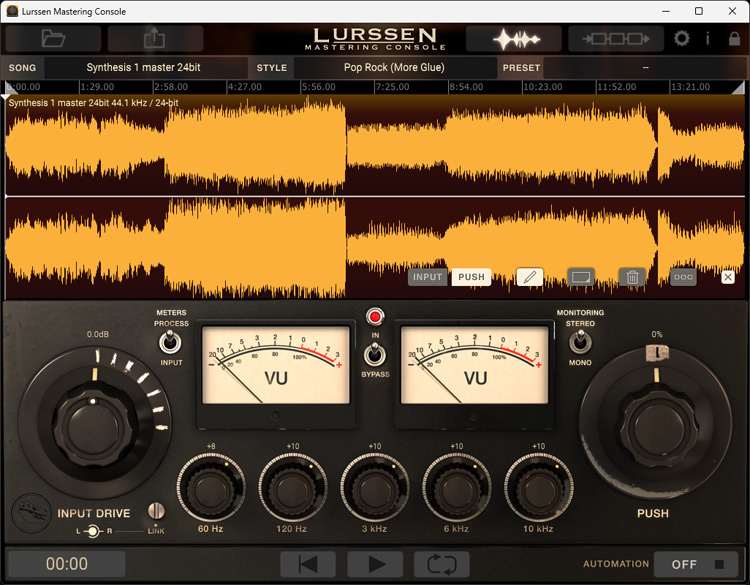
At the top of the screen in the stand-alone version, there are two icons that can be used to switch between the waveform display and the signal path display. When using the plug-in with real-time processing, there is no need to switch. In the lower part of the console, there are VU level meters, input level and push knobs, as well as five filters with fixed filter frequencies that can be adjusted in their gain. The push knob is used to adjust the gain settings of all filters at once.
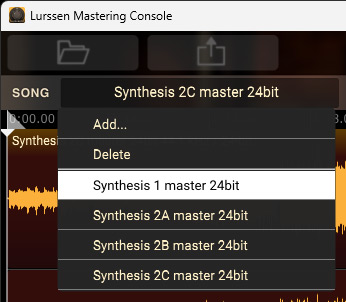
In the standalone version, a complete project or the individual songs of a project can be loaded or saved on the left side of the header. The SONG menu can then be used to select the song to be edited (see figure above).

When you switch to the signal path tab, the concept of the Lurssen Mastering Console becomes clear. In contrast to the T-RackS Mastering Console, predefined processor arrangements are loaded here via presets, some of which are already preset accordingly.
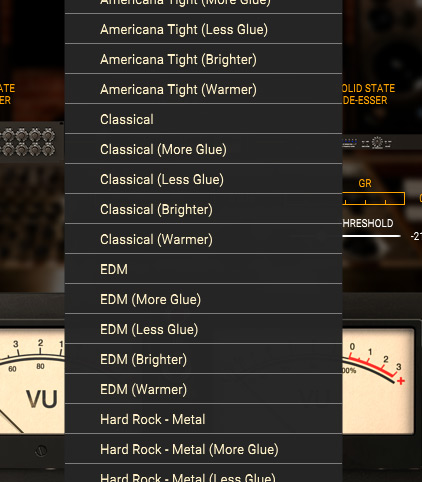
A total of 40 presets are available, organized by musical genre and sound coloration.

The signal path with the individual processors, such as an equalizer, limiter, de-esser, and compressor, includes level meters and, where applicable, parameters that can be changed, such as threshold values for the de-esser or compressor and makeup gain.

The number of adjustable parameters is manageable. TheLurssen Mastering Console is therefore aimed at a target group that wants to do their own mastering, if necessary, directly in the stereo sum after finishing the mix with a manageable amount of effort and options for intervention. The crucial factor for the sound is the selection of the preset, as the filter settings are predetermined by this. Therefore, a downstream Lurssen Mastering EQ could also be helpful here to make adjustments based on your own ideas. However, I think that if you want to do that, you should choose a different workflow and assemble and configure the mastering components yourself, using software or an editor that is suitable for mastering - or use the IK Multimedia T-RackS Mastering Console, which offers significantly more flexibility.
Conclusion
We don't want to mention prices at this point, as there are often specials on these products. You should check the IK Multimedia website for information. In addition to the bundle described here, a bundle which includes the T-RackS 6 MAX is also offered. This can be particularly interesting in terms of price, and many more very interesting products for audio mastering are available here.
The Lurssen Mastering EQ is a truly impressive equalizer, especially for mastering applications. It can be adjusted in great detail and allows for very good sound shaping of already mixed productions, where you want to bring out the final details. A real recommendation for mastering engineers. I will definitely be using the EQ more often.
The Lurssen Mastering Console, on the other hand, is a solution for users who want to minimize the effort involved in mastering and get the job done quickly, while also not wanting to outsource the mastering. You can significantly improve your own mixing results with the Lurssen Mastering Console, and a lot of Gevin Lurssen and Reuben Cohen's expertise has gone into it. However, you should not expect the same results as a mastering engineer with years of experience and a range of highly specialized audio processors.
 How to resolve AdBlock issue?
How to resolve AdBlock issue? 